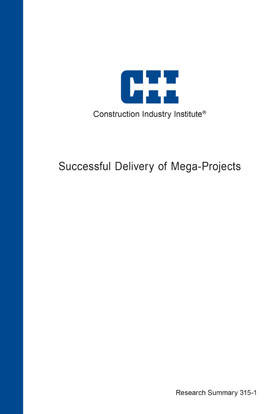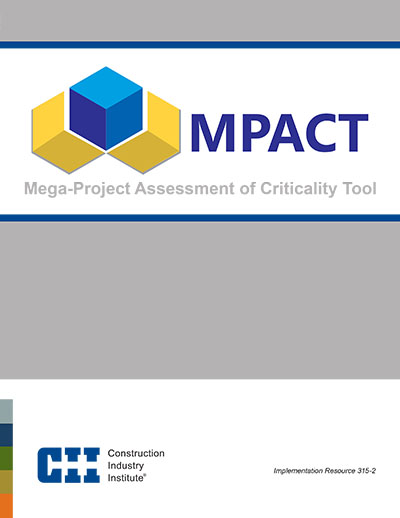
Successful Delivery of Mega-Projects
The increase in global population demands in recent decades has created serious constraints on resources and put immense pressure on already deteriorating infrastructures around the world. As the demand for new facilities has grown, technological advances have allowed the construction industry to pursue previously unattainable economies of scale, and the result of both trends has been that the size of capital projects has grown substantially. The prevailing term for these very large efforts is “mega-projects.” Although not precisely defined, the term is generally used to describe projects with capital budgets exceeding one billion dollars. As the number and size of mega-projects continues to increase across all sectors of the capital projects industry, one fact stands out: mega-projects tend to underperform more often than not. More specifically, mega-projects fail to keep within their approved budgets, fail to meet their approved schedules, or fail to achieve their premised business objectives.
While it would seem that the proper deployment of traditional project management techniques should keep mega-projects on track, this has not proven to be the case. Even when organizations use best practices and proven scope definition assessment methods, mega-projects often fail to achieve their objectives. Recognizing the enormous amount of capital dollars at stake and the prevailing trend towards poor performance, the Construction Industry Institute initiated Research Team (RT) 315, Successful Delivery of Mega-Projects, to determine why these projects fail and how to prevent or reduce these failures. Specifically, RT 315 sought to answer the following question: “What sorts of changes in project development and execution are needed to increase the likelihood of success on mega-projects?”
RT 315 pursued the following research objectives: 1) describe the current state of the practice in mega-project delivery; 2) rank the root causes of poor performance of mega-projects; 3) identify changes in planning and execution practices to address these root causes and improve performance; and; 4) develop any appropriate tools to support proactive mega-project planning and execution. In conducting this research, RT 315 utilized a combination of literature review, surveys, interviews, and detailed case studies. After gathering data from more than 100 projects, the research team identified 34 impact factors with high occurrence and high negative performance impact on mega-projects. The team also prioritized the factors with the most negative impact on mega-project outcomes.
While determining which factors are more likely to occur and which have more negative impacts on mega-projects were valuable first steps, the research team went deeper by identifying specific case examples of how the negative impacts might manifest themselves on a project. Furthermore, for each of the factors, the team identified specific mitigation strategies and recommendations to adopt during front end planning and execution. All of these results have been incorporated into Implementation Resource (IR) 315-2, Mega-Project Assessment of Criticality Tool (MPACT), an Excel-based tool and guide.
The MPACT tool is a flexible resource that allows project teams to assess which impact factors are relevant to their projects, assign project-specific criticality assessments, incorporate project team comments, access real project case examples and recommendations, and generate customized reports. MPACT is designed to complement but not replace any existing organizational processes; its output can supplement any of an organization’s other project planning and execution processes. In developing this tool, the research has gone beyond any previous generic lessons learned, to enable project teams to make structured assessments of critical mega-project impact factors. Assessing these impact factor will enable more accurate and thorough mitigation planning for them and, thus, improve mega-project performance.
A capital project with a total installed cost greater than $1 billion dollars with any of the following complexity criteria:
(RS315-1, p. 1)
- A significant number of stakeholders
- A large number of interfaces
- A challenging project location
- An inadequate supply of resources
- Unfamiliar technology
- Difficult regulatory constraints
- Extensive infrastructure requirements
- Geographically dispersed teams
- Significant political, economic, environmental, or social influence
The research identifies 34 impact factors, and validated that these factors have high occurrence and performance impacts on mega-projects. The research further identifies the 16 impact factors that, when they occur, most affect performance on mega-projects. The 34 impact factors were categorized into 5 categories: (RS315-1, p. 9)
- Category A – Location and Technology
- Category B – Team, Organization, and Communication
- Category C – Planning and Execution Processes
- Category D – Governance and Stakeholders
- Category E – Delivery Strategy
This tool synthesizes all the research findings into a targeted knowledge structure to help mega-project teams better understand the impact factors. Considering the characteristics unique to mega-projects, the main purpose of the tool is to increase understanding, highlight the importance, provide case study examples, and guide the assessment of these impact factors. (RS315-1, p. 25)
See Implementation Tools below for more information.
The case studies provide a breadth and depth of information on the impact factors, complementing the research data analysis effort and supporting the research findings. Case study findings were grouped by the five categories identified in Key Finding #2. Examples from each category include: (RS315-1, p. 21)
- Category A – Host governments of mega-projects are restricting the mass importation of craft workers.
- Category B – Both owners and contractors stressed the need to assign skilled and experienced personnel to lead mega-projects.
- Category C – Favorable business conditions and the urgency to get to market often influenced owners to skip key planning steps.
- Category D – As more mega-projects are undertaken as joint ventures, their governance becomes increasingly convoluted, with poorly defined roles and responsibilities.
- Category E – Host countries often require the use of local resources, where these local contractors and sub-contractors fail to perform.



